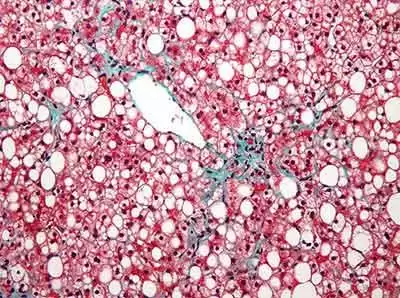
Celiac.com 06/22/2021 - People with celiac disease have a higher risk for developing non-alcoholic fatty liver disease (NAFLD) and other related metabolic disorders, especially if they are not on a gluten-free diet.
A team of researchers recently set out to explore the prevalence of NAFLD and metabolic-associated fatty liver disease in celiac patients at the time of celiac diagnosis and after 2 years of GFD; and to assess the role of PNPLA3 rs738409 in the development of NAFLD and metabolic-associated fatty liver disease in the celiac population.
Celiac.com Sponsor (A12):
Recently, a new category of metabolic-associated fatty liver disease (MAFLD) has been proposed to move beyond the constraints of the NAFLD definition.
The research team included Antonio Rispo; Nicola Imperatore; Maria Guarino; Raffaella Tortora; Anna Alisi; Valentina Cossiga; Anna Testa; Simona Ricciolino; Andrea Fiorentino; and Filomena Morisco.
They are variously affiliated with the Gastroenterology, Department of Clinical Medicine and Surgery, School of Medicine Federico II of Naples, Naples, Italy; the Gastroenterology and Endoscopy Unit, AORN Antonio Cardarelli, Naples, Italy; the Hepatology Unit, AORN A. Cardarelli, Naples, Italy; and the Research Unit of Molecular Genetics and Complex Phenotypes, Bambino Gesù Children's Hospital, IRCCS, Rome, Italy.
For the study, the team retrospectively enrolled all newly diagnosed celiac patients who underwent clinical, laboratory and ultrasonography investigations, both at diagnosis and at a two year follow-up. They also conducted a PNPLA3 rs738409 genotyping assay.
They found that 65 of 221 newly diagnosed celiac patients, nearly 30%, presented NAFLD upon celiac diagnosis, while 32 of 221 met the criteria for metabolic-associated fatty liver disease.
There were no major differences between NAFLD and metabolic-associated fatty liver disease, though 3 out of 4 metabolic-associated fatty liver disease patients had higher rates of insulin resistance (IR) compared with 2 out of 5 for NAFLD patients.
The study shows that the newly established metabolic-associated fatty liver disease definition better describes the metabolic changes common when celiacs adopt a gluten-free diet.
The new classification may help to spot patients at risk of worse metabolic outcomes, who will likely benefit from a close multidisciplinary approach for their multi-systemic disease.
Keep an eye on celiac.com for more stories on celiac disease and metabolic-associated fatty liver.
Read more in Liver International. 2021;41(4):788-798.










Recommended Comments
Create an account or sign in to comment
You need to be a member in order to leave a comment
Create an account
Sign up for a new account in our community. It's easy!
Register a new accountSign in
Already have an account? Sign in here.
Sign In Now